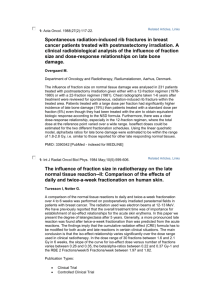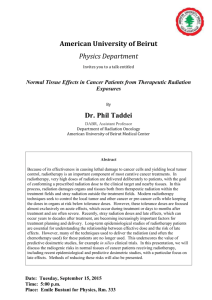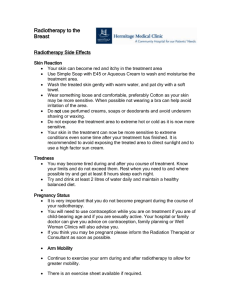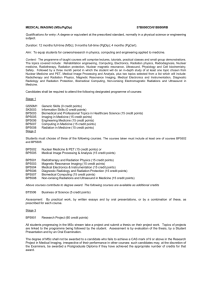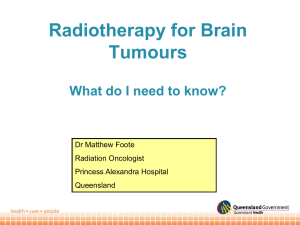Physics of Radiotherapy - HEMN'S MEDICAL PHYSICS WEBSITE
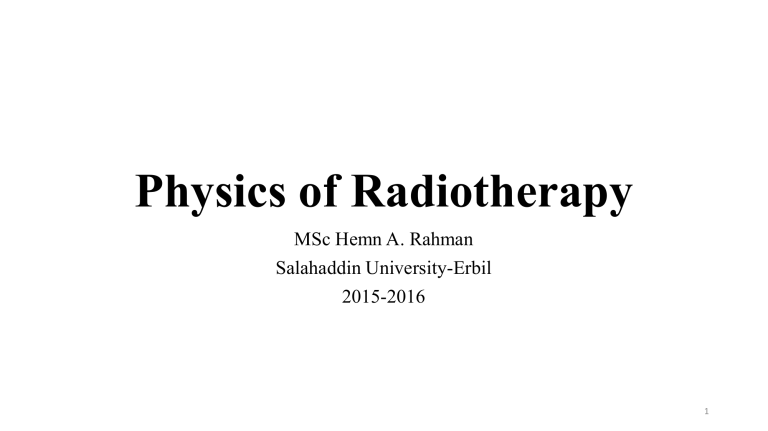
Physics of Radiotherapy
MSc Hemn A. Rahman
Salahaddin University-Erbil
2015-2016
1
Covered in Module
2
Recommended Reading
3
Assumed Knowledge
Basic human anatomy and physiology
Radioactivity
Interaction of radiation with matter
Basic dosimetric units
4
Outline
Human cell and cell-cycle
Cancer and its risks and risk factors
Cancer treatment options
Definition of radiotherapy
Tissue irradiation
Cell damage
TCP and NTCP
Therapeutic ratio
Fractionation in radiotherapy
Radiotherapy treatment
Brachytherapy
Some side effects of radiotherapy
5
The Human Cell
NOTE: JUST HAVE A LOOK.
6
The Cell Cycle
Phases of the cell cycle:
For more: Human cell-cycle video
NOTE: STUDENTS SHOULD KNOW THE PHASES OF THE CELL CYCLE.
7
Cancer
Cancer is characterized by a disorderly proliferation of cells that can invade adjacent tissues and spread via the lymphatic system or blood vessels to other parts of the body (metastases).
8
Cancers
Tumours: benign or malignant
Secondary cancer or metastasis
>200 different cancers
85% carcinomas – originate in epithelium –common forms breast, lung, prostate and bowel
Carcinomas are named after the type of epithelial cell that they originate in and the part of the body
9
Risk of Cancer
250,000 are diagnosed with cancer in the UK per year
1 in 3 people will develop cancer during their lifetime.
64% of all newly diagnosed cancers occur in people aged 65 years or more
The most recent statistics for the UK (from 2003) show that for men the most common cancer is prostate(23%), followed by lung (16%) large bowel(14%) and bladder (5%).
For women the figures are breast(31%), large bowel(11%), lung(11%) and ovary (5%).
10
Cancer Risk Factors
Old age
Tobacco
Sunlight
Ionizing radiation
Some chemicals and substances
Some viruses and bacteria
Certain hormones
Family history
Alcohol
Poor diet, lack of physical activity, overweight
11
Effect of Tobacco
50% of smokers will die from smoking related illnesses
Accounts for 30% of all cancer deaths, 87% of lung cancers
Risk of developing lung cancers 23% higher in male smokers than male non-smokers
12
Treatment options of Cancer
Surgery often used if the cancer is only in one area of the body and has not spread.
It may be used to remove lymph nodes if these are also affected by the cancer.
Chemotherapy cytotoxic drugs.> 50 different chemotherapy drugs. Tablets or capsules but most by infusion into a vein. The drugs go into the bloodstream and travel throughout the body to treat the cancer cells wherever they are. often a combination of two, three or more drugs is given.
Hormonal therapy
13
Treatment options of Cancer (Cont.)
Biological therapy
– Monoclonal antibodies are drugs that can 'recognise' and find specific cells in the body. They can be designed to find a particular type of cancer cell, attach itself to them and destroy them. They can also carry a radioactive molecule, which then delivers radiation directly to the cancer cells.
– Cancer growth inhibitors: interfere with the way cancer cells use
'chemical messengers' to help the cell to develop and divide.
– Vaccines and gene therapy: research is in the very early stages.
Radiation Therapy
– External Beam Radiotherapy
– Brachytherapy
14
What is Radiotherapy ?
Treatment of disease with radiation.
15
What is Radiotherapy ? (cont.)
Electromagnetic radiation, such as x-rays, gamma rays, electron beams or protons, used to kill or damage cancer cells to stop/slow them from growing or multiplying.
Radiotherapy can take place before, during or after treatment and in conjunction with other treatments such as chemotherapy or surgery.
About 50% of all cancer patients receive some form of radiation therapy during the course of their treatment.
16
Cancer & Radiotherapy
Cancer is characterized by a disorderly proliferation of cells that can invade adjacent tissues and spread via the lymphatic system or blood vessels to other parts of the body (metastases).
The aim of radiotherapy is to deliver enough radiation to the tumour to destroy it without irradiating normal tissue to a dose that will lead to serious complications (morbidity).
Treatment either radical or palliative
17
Tissue irradiation
When ionizing radiation is absorbed in biological material, the damage to the cell may occur in one of two ways: direct or indirect.
In direct action, charged particles with sufficient energy directly interact with the critical target in the cell (DNA or Cell membrane). The atoms of the target itself may be ionized or excited through Coulomb interactions, leading to the chain of physical and chemical events that eventually produce the biological damage.
In indirect action, photons interact with other molecules and atoms (mainly water) within the cell to produce free radicals, which can, eventually, damage the critical target within the cell.
18
Cell damage
Radiation damage to mammalian cells is divided into three categories:
– Lethal damage (irreversible, cell death)
– Sublethal damage (reversible unless additional damage is added)
– Potentially lethal damage (can be manipulated by repair when cells are allowed to remain in a non-dividing state)
19
Fate of irradiated cells
No effect.
Division delay
Apoptosis
Reproductive failure
Genomic instability
Mutation
Transformation
Bystander effects
Adaptive responses
20
TCP & NTCP
The principle of radiotherapy is usually illustrated by plotting two sigmoid curves.
– For tumour control probability (TCP)
– For normal tissue complication probability (NTCP)
21
Therapeutic ratio
The concept of the therapeutic ratio is often used to represent the optimal radiotherapy treatment.
Therapeutic ratio generally refers to the ratio of the TCP and NTCP at a specified level of response (usually 0.05) for normal tissue
22
Therapeutic ratio (cont.)
The further the NTCP curve is to the right of the TCP curve:
– the easier it is to achieve the radiotherapeutic goal
– the larger is the therapeutic ratio
– the less likely are treatment complications
23
Fractionation
Fractionation of radiation treatment so that it is given over a period of weeks rather than in a single session results in a better therapeutic ratio
( better tumour control with less severe side effects).
To achieve the desired level of biological damage the total dose in a fractionated treatment must be much larger than that in a single treatment.
24
Fractionation
The basis of fractionation is rooted in 5 primary biological factors called the five R’s of radiotherapy:
–
R adiosensitivity : Mammalian cells have different radio-sensitivities.
– R epair : Mammalian cells can repair radiation damage.
–
R epopulation : During a 4- to 6-week course of radiotherapy, tumour cells that survive irradiation may proliferate and thus increase the number of cells which must be killed.
–
R edistribution: Cell-cycle progression effects. Cells that survive a first dose of radiation will tend to be in a resistant phase of the cell cycle, and within a few hours, they may progress into a more radiosensitive phase (G1 & Mitosis phase )
– R eoxygenation of hypoxic cells occurs during a fractionated course of treatment, making them more radiosensitive to subsequent doses of radiation.
25
Fractionation
Conventional fractionation is explained as follows:
– Division of dose into multiple fractions spares normal tissues through repair of sublethal damage between dose fractions and repopulation of cells.
– The repair of sublethal damage is greater for late responding tissues, the repopulation of cells is greater for early responding tissues.
26
Fractionation (cont.)
Conventional fractionation is explained as follows (cont.):
– Fractionation increases tumour damage through reoxygenation and redistribution of tumour cells
– A balance is achieved between the response of tumour and early and late responding normal tissues, so that small doses per fraction spare late reacting tissues preferentially, and a reasonable schedule duration allows regeneration of early responding tissues and tumour reoxygenation likely to occur.
27
Fractionation
The current standard fractionation is based on:
– 5 daily treatments per week (Monday to Friday)
– 1.8 to 2.0 Gy/fraction
– a total treatment time of several weeks
This regimen reflects:
– the practical aspects of dose delivery to a patient
– Successful outcome of patient’s treatments
– Convenience to staff delivering the treatment
28
Fractionation
In addition to the standard fractionation regimens, other fractionation schemes are being studied with the aim of improving the therapeutic ratio:
–
Hyperfractionation uses more than one fraction per day with a smaller dose per fraction (<1.8 Gy) to reduce long term complications and to allow delivery of higher total tumour dose.
–
Accelerated fractionation reduces the overall treatment time, minimizing tumour cell repopulation during the course of treatment.
–
Continuous hyperfractionated accelerated radiation therapy (CHART) is an experimental programme used with three fractions per day for 12 continuous days.
29
Purpose of Radiotherapy (RECAP)
Deliver radiation dose accurately
Increase radiation dose to tumour to improve local control
Minimise radiation dose to critical structures to reduce radiation toxicity
30
Radiotherapy Process
Diagnosis
Therapeutic Decisions
Target Volume Localisation
Fabrication of Treatment Aids
Treatment Planning
Simulation
Treatment
Patient Evaluation during treatment
Patient Follow up
31
Radiotherapy Treatment Planning process
1. CT scanning 6. Radiotherapy treatment 5. Virtual simulation
2. Tumour localization 3. Skin reference marks
4. Treatment planning
32
Brachytherapy
Method of radiation treatment in which sealed radioactive source is used to deliver the dose to a short distance by
– Interstitial (direct insertion into tissue)
– intracavitary(placement within a cavity)
– surface application (molds)
Radiation sources may be form of needles, narrow tubes, wires or small beads.
Most commonly used radioisotope in head and neck regions are iridium 192, cesium137 and radium 226.
33
Brachytherapy (cont.)
Template
US probe
Supporting unit and stepping system
Afterloader
Brachy seeds
Template
34
Brachytherapy (cont.)
Infatable balloon
Needle injection site
Radioactive source port pathway
Catheter line to the balloon
35
Advantages and disadvantages of Brachytherapy
Advantages
– Rapid decrease in dose with distance from radiation source (inverse square law).
– Thus a high radiation dose can be given to the tumor while sparing surrounding normal tissues.
– Thus continuous low dose irradiation tends to synchronize the cell cycle and allows sublethal damage repair.
Disadvantages
– Inhomogeneity
– Needs a skilful operator to achieve good dose distribution
– Exposure to the therapist the room personnel
36
Possible side effects of RT
Side effects of radiation depend on the area is being treated:
Hair loss
mouth dryness or mouth sores
Skin changes, itching, skin dryness
Diarrhea
Swelling of the area being treated
Nausea and vomiting
Bladder dysfunction
37

